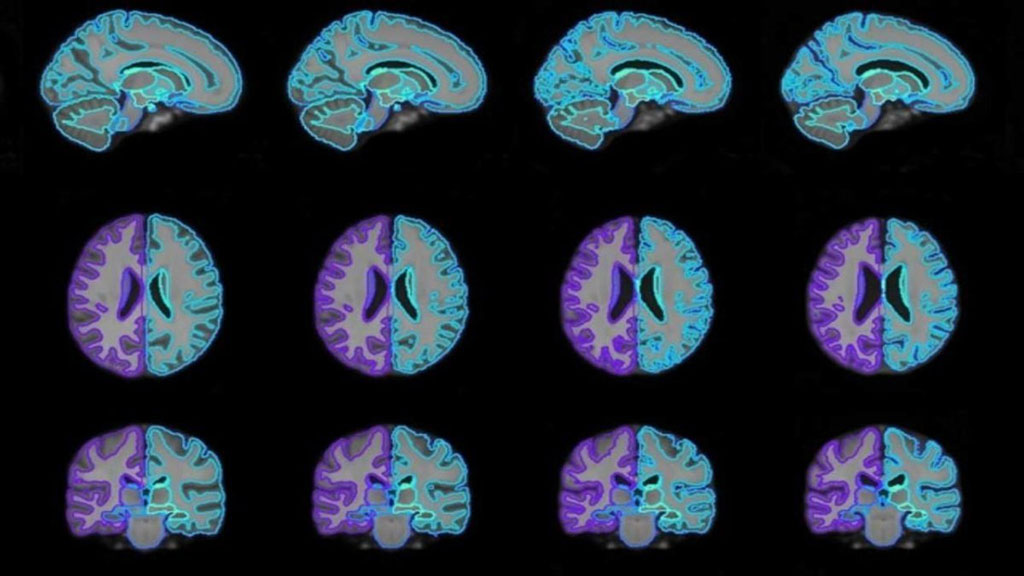Automated Modelling Synthesizes Brain Scan Templates
|
By HospiMedica International staff writers Posted on 09 Dec 2019 |

Image: On-demand brain scan templates of various ages generated using the joint CNN platform (Photo courtesy of MIT)
Automated neural network models accelerate the creation and customization of conditional atlases used in medical-image analysis.
Developed at the Massachusetts Institute of Technology (MIT, Cambridge, MA, USA) and Cornell University (Cornell; Ithaca, NY, USA), the probabilistic model is based on one conditional neural network (CNN) that yields either universal or conditional templates, and another CNN that provides efficient alignment of the images to templates. The joint CNN is fed a random image from a dataset encoded with desired patient attributes; from that, it estimates an attribute-conditional atlas. The second CNN aligns the estimated atlas with the input image, generating a deformation field, which is then used to train a loss function to reduce deviations from a given value, thus learning to minimize differences between the learned atlas and each image.
The networks continuously refine the atlas to smoothly align to any given image across the dataset. The result is an atlas that has learned how specific attributes, such as age, sex, and disease, correlate to structural variations across all images in a dataset. By plugging new patient attributes into the function, it leverages all learned information across the dataset to synthesize an on-demand atlas, even if that attribute data is missing or scarce in the dataset. The study was presented at the annual conference on Neural Information Processing Systems, held during December 2019 in Vancouver (Canada).
“A big dream is to build one function that can generate conditional atlases for any subpopulation, spanning birth to 90 years old. Researchers could log into a webpage, input an age, sex, diseases, and other parameters, and get an on-demand conditional atlas,” said lead author and study presenter Adrian Dalca, PhD, of MIT. “That would be wonderful, because everyone can refer to this one function as a single universal atlas reference. Atlases are central to many medical image analyses; this method can build a lot more of them, and build conditional ones as well.”
Traditional atlas-building methods run lengthy, iterative optimization processes on all images in a dataset. For example, they align all 3D brain scans to an initial (often blurry) atlas, and compute a new average image from the aligned scans. They repeat this iterative process for all images. This computes a final atlas that minimizes the extent to which all scans in the dataset must deform to match the atlas. Doing this process for patient subpopulations can be complex and imprecise if there isn't enough data available.
The atlases are available online at the MIT VoxelMorph library.
Related Links:
Massachusetts Institute of Technology
Cornell University
VoxelMorph library
Developed at the Massachusetts Institute of Technology (MIT, Cambridge, MA, USA) and Cornell University (Cornell; Ithaca, NY, USA), the probabilistic model is based on one conditional neural network (CNN) that yields either universal or conditional templates, and another CNN that provides efficient alignment of the images to templates. The joint CNN is fed a random image from a dataset encoded with desired patient attributes; from that, it estimates an attribute-conditional atlas. The second CNN aligns the estimated atlas with the input image, generating a deformation field, which is then used to train a loss function to reduce deviations from a given value, thus learning to minimize differences between the learned atlas and each image.
The networks continuously refine the atlas to smoothly align to any given image across the dataset. The result is an atlas that has learned how specific attributes, such as age, sex, and disease, correlate to structural variations across all images in a dataset. By plugging new patient attributes into the function, it leverages all learned information across the dataset to synthesize an on-demand atlas, even if that attribute data is missing or scarce in the dataset. The study was presented at the annual conference on Neural Information Processing Systems, held during December 2019 in Vancouver (Canada).
“A big dream is to build one function that can generate conditional atlases for any subpopulation, spanning birth to 90 years old. Researchers could log into a webpage, input an age, sex, diseases, and other parameters, and get an on-demand conditional atlas,” said lead author and study presenter Adrian Dalca, PhD, of MIT. “That would be wonderful, because everyone can refer to this one function as a single universal atlas reference. Atlases are central to many medical image analyses; this method can build a lot more of them, and build conditional ones as well.”
Traditional atlas-building methods run lengthy, iterative optimization processes on all images in a dataset. For example, they align all 3D brain scans to an initial (often blurry) atlas, and compute a new average image from the aligned scans. They repeat this iterative process for all images. This computes a final atlas that minimizes the extent to which all scans in the dataset must deform to match the atlas. Doing this process for patient subpopulations can be complex and imprecise if there isn't enough data available.
The atlases are available online at the MIT VoxelMorph library.
Related Links:
Massachusetts Institute of Technology
Cornell University
VoxelMorph library
Latest AI News
Channels
Critical Care
view channel
AI Heart Attack Risk Assessment Tool Outperforms Existing Methods
For decades, doctors have relied on standardized scoring systems to assess patients with the most common type of heart attack—non-ST-elevation acute coronary syndrome (NSTE-ACS). The GRACE score, used... Read more
'Universal' Kidney to Match Any Blood Type
Blood-type incompatibility has long been one of the greatest obstacles in organ transplantation, forcing thousands of patients—particularly those with type O blood—to wait years longer for compatible donors.... Read moreSurgical Techniques
view channel
Minimally Invasive Endoscopic Surgery Improves Severe Stroke Outcomes
Intracerebral hemorrhage, a type of stroke caused by bleeding deep within the brain, remains one of the most challenging neurological emergencies to treat. Accounting for about 15% of all strokes, it carries... Read more
Novel Glue Prevents Complications After Breast Cancer Surgery
Seroma and prolonged lymphorrhea are among the most common complications following axillary lymphadenectomy in breast cancer patients. These postoperative issues can delay recovery and postpone the start... Read morePatient Care
view channel
Revolutionary Automatic IV-Line Flushing Device to Enhance Infusion Care
More than 80% of in-hospital patients receive intravenous (IV) therapy. Every dose of IV medicine delivered in a small volume (<250 mL) infusion bag should be followed by subsequent flushing to ensure... Read more
VR Training Tool Combats Contamination of Portable Medical Equipment
Healthcare-associated infections (HAIs) impact one in every 31 patients, cause nearly 100,000 deaths each year, and cost USD 28.4 billion in direct medical expenses. Notably, up to 75% of these infections... Read more
Portable Biosensor Platform to Reduce Hospital-Acquired Infections
Approximately 4 million patients in the European Union acquire healthcare-associated infections (HAIs) or nosocomial infections each year, with around 37,000 deaths directly resulting from these infections,... Read moreFirst-Of-Its-Kind Portable Germicidal Light Technology Disinfects High-Touch Clinical Surfaces in Seconds
Reducing healthcare-acquired infections (HAIs) remains a pressing issue within global healthcare systems. In the United States alone, 1.7 million patients contract HAIs annually, leading to approximately... Read moreHealth IT
view channel
Printable Molecule-Selective Nanoparticles Enable Mass Production of Wearable Biosensors
The future of medicine is likely to focus on the personalization of healthcare—understanding exactly what an individual requires and delivering the appropriate combination of nutrients, metabolites, and... Read moreBusiness
view channel
Philips and Masimo Partner to Advance Patient Monitoring Measurement Technologies
Royal Philips (Amsterdam, Netherlands) and Masimo (Irvine, California, USA) have renewed their multi-year strategic collaboration, combining Philips’ expertise in patient monitoring with Masimo’s noninvasive... Read more
B. Braun Acquires Digital Microsurgery Company True Digital Surgery
The high-end microsurgery market in neurosurgery, spine, and ENT is undergoing a significant transformation. Traditional analog microscopes are giving way to digital exoscopes, which provide improved visualization,... Read more
CMEF 2025 to Promote Holistic and High-Quality Development of Medical and Health Industry
The 92nd China International Medical Equipment Fair (CMEF 2025) Autumn Exhibition is scheduled to be held from September 26 to 29 at the China Import and Export Fair Complex (Canton Fair Complex) in Guangzhou.... Read more
















